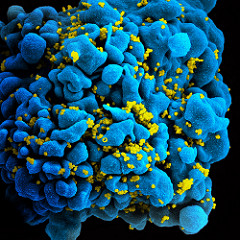Aggregated News

Scanning electromicrograph of an
HIV-infected T cell. NIAID via wikimedia
A woman of mixed race appears to be the third person ever to be cured of H.I.V., using a new transplant method involving umbilical cord blood that opens up the possibility of curing more people of diverse racial backgrounds than was previously possible, scientists announced on Tuesday.
Cord blood is more widely available than the adult stem cells used in the bone marrow transplants that cured the previous two patients, and it does not need to be matched as closely to the recipient. Most donors in registries are of Caucasian origin, so allowing for only a partial match has the potential to cure dozens of Americans who have both H.I.V. and cancer each year, scientists said.
The woman, who also had leukemia, received cord blood to treat her cancer. It came from a partially matched donor, instead of the typical practice of finding a bone marrow donor of similar race and ethnicity to the patient’s. She also received blood from a close relative to give her body temporary immune defenses...



